
Boraginaceae, the borage or forget-me-notfamily, includes about 2,000 species of shrubs, trees, and herbs in 146 to 156 genera with a worldwide distribution.

Buddleja is a genus comprising over 140 species of flowering plants endemic to Asia, Africa, and the Americas. The generic name bestowed by Linnaeus posthumously honoured the Reverend Adam Buddle (1662–1715), an English botanist and rector, at the suggestion of Dr. William Houstoun. Houstoun sent the first plants to become known to science as buddleja to England from the Caribbean about 15 years after Buddle's death. Buddleja species, especially Buddleja davidii and interspecific hybrids, are commonly known as butterfly bushes and are frequently cultivated as garden shrubs. Buddleja davidii has become an invasive species in both Europe and North America.
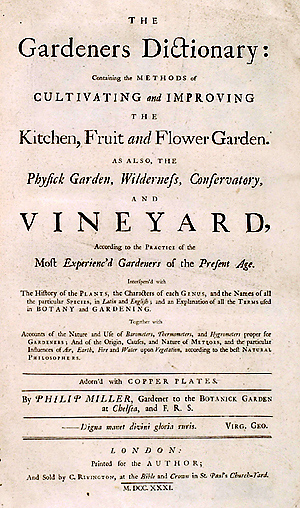
Philip Miller FRS was an English botanist and gardener of Scottish descent. Miller was chief gardener at the Chelsea Physic Garden for nearly 50 years from 1722, and wrote the highly popular The Gardeners Dictionary.

The blue spruce, also commonly known as green spruce, Colorado spruce, or Colorado blue spruce, is a species of spruce tree. It is native to North America, and is found in USDA growing zones 1 through 7. It is found naturally in Arizona, Colorado, Idaho, New Mexico, Utah and Wyoming. It has been widely introduced elsewhere and is used as an ornamental tree in many places far beyond its native range. The blue spruce has blue-green colored needles and is a coniferous tree.

The Marie Selby Botanical Gardens is a 15-acre (6.1 ha) botanical garden located at 900 South Palm Avenue in Sarasota, Florida. The Gardens are located on the grounds of the former home of Marie and William Selby. The Gardens acquired the Historic Spanish Point campus on May 1, 2020.
The Marie Selby Botanical Gardens is a Smithsonian affiliate, and is accredited by the American Alliance of Museums.

Allium canadense, the Canada onion, Canadian garlic, wild garlic, meadow garlic and wild onion is a perennial plant native to eastern North America from Texas to Florida to New Brunswick to Montana. The species is also cultivated in other regions as an ornamental and as a garden culinary herb. The plant is also reportedly naturalized in Cuba.
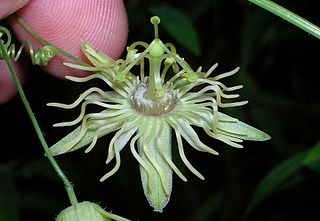
Passiflora lutea, commonly known as yellow passionflower, is a flowering perennial vine in the family Passifloraceae, native to the central and eastern United States. The vine has three-lobed leaves and small, yellowish-green, fringed flowers that appear in the summer, followed by green fruit that turn almost black at maturity. It grows in moist to wet habitats.

Gomphrena globosa, commonly known as globe amaranth, is an edible plant from the family Amaranthaceae. The round-shaped flower inflorescences are a visually dominant feature and cultivars have been propagated to exhibit shades of magenta, purple, red, orange, white, pink, and lilac. Within the flowerheads, the true flowers are small and inconspicuous.

Rubus trifidus is a Japanese species of brambles, related to blackberries and raspberries.

Buddleja globosa, also known as the orange-ball-tree, orange ball buddleja, and matico, is a species of flowering plant endemic to Chile and Argentina, where it grows in dry and moist forest, from sea level to 2,000 m. The species was first described and named by Hope in 1782.
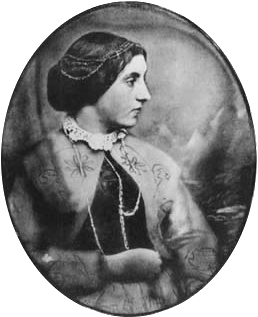
Jane Wells Webb Loudon was an English author and early pioneer of science fiction. She wrote before the term was coined, and was discussed for a century as a writer of Gothic fiction, fantasy or horror. She also created the first popular gardening manuals, as opposed to specialist horticultural works, reframing the art of gardening as fit for young women. She was married to the well-known horticulturalist John Claudius Loudon, and they wrote some books together, as well as her own very successful series.
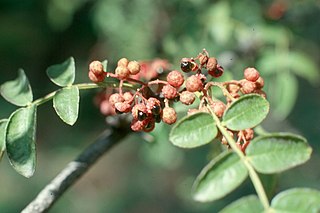
Zanthoxylum americanum, the common prickly-ash, common pricklyash, common prickly ash or northern prickly-ash, is an aromatic shrub or small tree native to central and eastern portions of the United States and Canada. It is the northernmost New World species in the citrus family, Rutaceae, and is the type species in its genus, which includes sichuan pepper. It can grow to 10 meters (33 ft) tall with a diameter at breast height (DBH) of 15 cm (5.9 in). It produces membranous leaflets and axillary flower clusters. The wood is not commercially valuable, but oil extracts from the bark have been used in traditional and alternative medicine, and have been studied for antifungal and cytotoxic properties. The genus name is sometimes spelled Xanthoxylum.
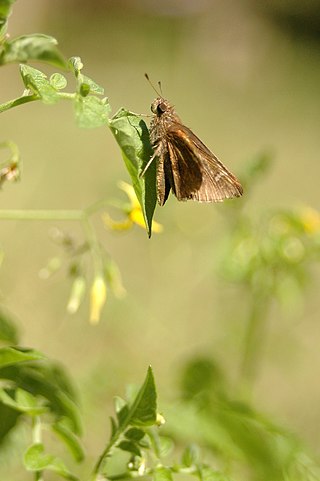
Lerema accius, the clouded skipper, is a butterfly of the family Hesperiidae. It is found in the United States from Georgia west to Texas, south to Florida, and south through Mexico and Central America to Venezuela and Colombia.

Varronia curassavica, synonym Cordia curassavica, commonly known as black sage or wild sage, is a species of flowering plant in the borage family, Boraginaceae. It is sometimes called tropical black sage to distinguish it from another unrelated species named black sage, Salvia mellifera. It is native to tropical America but has also been widely introduced to Southeast Asia and the tropical Pacific region, where it is an invasive weed. The specific epithet is a latinised form of Curaçao, an island in the southern Caribbean Sea region and the locality of the type collection.

Convolvulus erubescens, commonly known as blushing bindweed, or Australian bindweed, is a perennial herbaceous plant in the family Convolvulaceae that is endemic to Australia.
Varronia leucophlyctis, synonym Cordia leucophlyctis, is a shrubby plant in the borage family (Boraginaceae), endemic to the Galápagos Islands. It has tubular white flowers.
Helianthus agrestis is a species of sunflower known by the common name southeastern sunflower. It is one of 150 sunflower species in the genus Helianthus. It is found only in the states of Florida and Georgia in the southeastern United States. This plant is native to Florida. It grows in wet soil in marshes and pine flatwoods at elevations less than 50 meters elevation.
Varronia polycephala, synonym Cordia polycephala, is a native plant of the Virgin Islands that is commonly found in open distributed areas. The flowers are sessile and the inflorescences are simple or branched. Fruits are usually bright red and 3-4 millimeters in diameter, covered by an enlarged calyx.

Varronia is a genus of flowering plants in the family Boraginaceae, found throughout Latin America, the Caribbean, and in the US states of Texas and Florida. They were resurrected from Cordia in 2007.
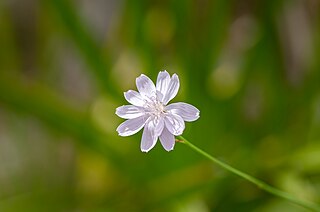
Lygodesmia aphylla is a species of flowering plant in the family Asteraceae known by the common name rose rush or rushweed. It has white, pink, or lavender flowers. It grows in Florida and Georgia and reaches between 1 and 3 feet tall.
















